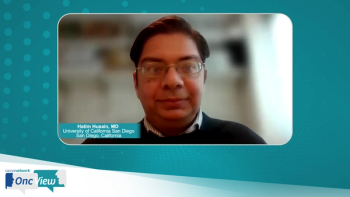
Individualizing Extended Adjuvant Therapy in HR+ Breast Cancer
This article reviews individualizing extended adjuvant therapy for patients with HR+ breast cancer and includes insights from Vijayakrishna (V. K.) Gadi, MD, PhD, of the University of Illinois in Chicago, and Reshma L. Mahtani, DO, of the University of Miami Health System in Deerfield Beach, FL.
In the setting of hormone receptor–positive (HR+), HER2-negative, lymph node–negative (pN0) breast cancer, postsurgical antiestrogen therapy (ie, adjuvant endocrine therapy) with tamoxifen or an aromatase inhibitor is recommended for at least 5 years to reduce the risk of recurrence and extend the disease-free survival (DFS) interval.1 However, some patients benefit from extending adjuvant endocrine therapy beyond 5 years.1 Identifying which patients are most likely to benefit from extended therapy while sparing others from prolonged drug exposure may become easier with a new recommendation from the National Comprehensive Cancer Network (NCCN). This was the topic of discussion in a recent OncViewTM, which featured insights and perspectives from Vijayakrishna (V. K.) Gadi, MD, PhD, professor and director of medical oncology, Department of Medicine, associate director, translational oncology, University of Illinois, Chicago; and Reshma L. Mahtani, DO, associate professor of clinical medicine, Division of Hematology/Oncology; coleader of the Breast Cancer Program; director of community outreach, Sylvester Comprehensive Cancer Center, University of Miami Health System, Deerfield Beach, Florida.
NCCN-Recommended Assays
In the April 2021 version of its breast cancer guidelines, the NCCN endorsed the Breast Cancer Index (BCI) assay as one that can be treatment predictive in the HR+ setting.1 Individualized precision medicine continues to gain traction in breast cancer because of several commercially available bioassays, including the 21-gene (Oncotype Dx), 70-gene (MammaPrint), 50-gene (Prosigna), 12-gene (EndoPredict), and BCI gene expression assays.1 Although all these assays are recommended in NCCN guidelines as prognostic indicators to complement the TNM (tumor, node, metastasis) staging system and biomarker information, not all are predictive of treatment benefit associated with the pursuit of a particular therapeutic course.1
“Genomic assays really aim to give us a more in-depth understanding of the biology of the individual’s tumor by looking at various levels of gene expression,” explained Mahtani. “The information can aid in further prognostication beyond clin[ical]-path[ological] factors alone, and most importantly, [it] can help us predict the benefit, or sometimes the lack of benefit, of our treatments such as chemotherapy and endocrine therapy.”
In the realm of bioassays, Gadi explained that, if a test is prognostic, it provides information about “the chance the cancer could come back,” but if it is predictive, it provides “the chance that an intervention…works versus doesn’t work.” Tests with predictive ability refer to whether adjuvant chemotherapy should be recommended after surgery, but in the case of the BCI assay, its predictive ability references whether adjuvant endocrine therapy should be extended beyond 5 years. This makes the BCI unique among currently recommended bioassays used for those with HR+ breast cancer.
“Many of us forget that not too long ago, we were giving chemotherapy to the majority of women with localized breast cancer regardless of lymph node status, menopausal status, or [hormone] receptor status,” said Mahtani. “[However], the availability of genomic assays…has really allowed us to tailor our treatments much better and…spare women the toxicities for those who are…not benefiting from our treatments.”
Adjuvant Endocrine Therapy
Gadi explained that adjuvant endocrine therapy consists of either an agent that blocks estrogen receptors directly or an agent that blocks the enzyme responsible in the final step of converting pre-estrogens into active estrogens. The specific agents that can accomplish these goals are tamoxifen and aromatase inhibitors, respectively.1 To provide protection against early-stage recurrence (defined as disease recurrence ≤ 5 years after diagnosis), patients should receive one of these agents for at least 5 years following surgery. However, because some patients are at risk for late-stage disease recurrence (defined as disease recurrence > 5 years after diagnosis), these patients should continue receiving endocrine therapy for an additional 5 years to extend their DFS interval.2 Because only 3% to 5% of women with early-stage HR+ disease benefit from extended endocrine therapy, identifying these patients is important. Not only can doing so protect this small subset of patients, but it can also help to avoid overtreatment in the remaining 95%.2
“The thinking…in considering [extended adjuvant hormonal therapy] is that, for some patients, the risk of recurrence continues well beyond the 5 years post diagnosis,” explained Mahtani. She went on to state, “We typically make [the] decision on whether to extend…based on clinical-pathological features such as nodal status and tumor size. [Certainly] this information can be prognostic, but the challenge is that [clinical-pathological factors are] not always reliable, and that’s where we really need an additional piece of information.”
Extending Adjuvant Endocrine Therapy in Early-Stage HR+ Breast Cancer
In the April 2021 edition of the NCCN breast cancer guidelines, the BCI assay consensus statement was changed from having undetermined predictive value to being affirmatively predictive of benefit for extending adjuvant endocrine therapy in those with early-stage HR+ breast cancer, and it was assigned a category 2A recommendation.1 Mahtani and Gadi both pointed out that the BCI assay is currently the only gene expression assay that has consensus from the NCCN for being able to predict the benefit of extending endocrine therapy.
The nature of cancers that recur early (within the first 5 years after diagnosis) is that they tend to be highly proliferative, explained Gadi. Thus, the treatment approach has been to maximize therapy within that 5-year window to prevent recurrence by utilizing multiple layers of systemic therapy up front, including chemotherapy, novel biologics, and antiestrogen therapies. Conversely, Gadi noted how cancers that recur later (10-25 years after diagnosis) tend to be “lurking,” “slumber[ing],” or “hibernating” in the background for 1 or more decades, until they are “turn[ed] on again.” Extending endocrine therapy past the initial 5 years may be of benefit to prevent cancers that recur later.
The “benefit [of extending endocrine therapy] really should be balanced against the toxicities that many women who are on extended therapy face,” said Mahtani. “Many of these women are suffering with [adverse] effects…[that] significantly impact quality of life… and it’s a very frequent discussion I have in my clinic about how to manage the toxicities of endocrine therapy.”
The BCI can inform treatment decisions by identifying the subset of patients who should continue receiving adjuvant endocrine therapy past 5 years, which spares the remaining patients from extended drug exposure.
The Utility of the BCI Assay
The BCI assay is a combination of 2 genomic profiles: the HOXB13:IL17BR expression ratio (known as the H:I ratio) and the Molecular Grade Index (known as MGI).1 Those with a BCI score of 5.1 to 10 are considered high risk, and extending endocrine therapy has demonstrated significant improvement in DFS according to a retrospective analysis of data collected from 3 major trials: the MA.17, Trans-aTTom, and IDEAL trials.1 In patients in the low-risk category, “there was minuscule benefit [of] extend[ing] therapy,” explained Gadi. “[The] benefits were so low, yet there were all these risks from being on therapy for longer.” On the other hand, for patients with high-risk disease who extended therapy, “there was a 65% reduction in the risk of disease [recurrence].”
Gadi noted that, although these retrospective analyses have been highly insightful, these results need to be proved in prospective trials moving forward. He explained, “The hope is that if we can more carefully select patients who are going to benefit from being on the therapy for longer, then…we can lower the burden of women recurring later” by sparing them from toxic and harmful therapies needed to treat the late-stage recurrence down the road.
Mahtani added, “The [BCI] assay has been shown to provide an individualized risk of distant recurrence from years 5 to 10, and this information really can help inform the patients’…[and] physicians’ perception of their risk of recurrence above and beyond clin[ical]-path[ological] features. I’d say that I’ve been really surprised in my practice to see some of the assumptions that I’ve made using clin[ical]-path[ological] features be challenged by the results of the BCI, which have shown some patients with N1 disease to have a low rate of distant recurrence, while at the same time, [there have been] some patients where I expected their prognosis would be quite good…[because they were] N0, … [but they came] back with higher risk of distant recurrence. So I think [the BCI] has been very useful in my practice to help patients make this decision.”
Although the NCCN guidelines state that there are currently limited data regarding the utility of BCI in HR+, HER2-negative, lymph node–positive disease (pN+) disease, secondary analyses of the MA.17, Trans-aTTom, and IDEAL trials showed that patients who had a high BCI score and pN+ disease experienced significant improvements in DFS when adjuvant endocrine therapy was extended.1 “This [NCCN] recommendation [to use the BCI expression assay to predict benefit of extended endocrine therapy] includes both node-negative and node-positive patients,” clarified Mahtani.
When asked about how he utilizes genomic assays in his clinical practice, Gadi responded that he typically orders the 70-gene or the 21-gene assay around the time of surgery because these are predictive of whether adjuvant (postsurgical) chemotherapy is likely to provide benefit.1 Near the 5-year mark post surgery, Gadi then adopts a shared decision-making approach with regard to ordering the BCI assay. “I have a personal preference to practice medicine in a shared decision-making model. So that, for me, means going through the pros and cons of the [BCI] test and saying, ‘OK, this is the information we are going to unearth,’ and ‘Are you going to be comfortable knowing that and acting upon that?’ And if a patient says to me…‘I don’t care what the test says—I’m not doing those things,’ then I’m not going to burden them with that information.”
Unmet Needs
When queried about unmet needs in the treatment of early-stage HR+ breast cancer, Gadi noted that “we need better [antiestrogen] drugs.” He explained that there are already some novel antiestrogen therapies that are being developed and tested in the metastatic realm. The hope is that they will also prove their utility in treatment of early-stage disease as well. Gadi also noted that, although many studies are being done with novel drugs, “in terms of diagnostics, it’s a little bit different. We still don’t have a good sense of who really benefits.” This is why tests specifically designed to provide information about these things are needed, he explained. Even with the BCI assay, Gadi commented, there is still a subset of patients “[for whom] we know that the risk is a little higher, …but the test predicts no benefit from therapy,… [so] what do we do for these patients, and how can we keep them out of harm’s way with recurrences?”
Given that the NCCN endorses the BCI, Mahtani concluded by saying, “I think it will have a big impact in that patients [who] are not really benefiting from [extended] endocrine therapy may choose not to continue that treatment and not suffer those [adverse] effects.” She added that, although “we’ve made considerable progress, we still have quite a bit of work to do.”
REFERENCES
1. NCCN. Clinical Practice Guidelines in Oncology. Breast cancer, version 4.2021. Accessed April 28, 2021.
2. Breast cancer index. Biotheranostics Inc. Accessed May 6, 2021.
Newsletter
Stay up to date on recent advances in the multidisciplinary approach to cancer.




























































































